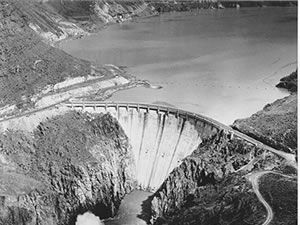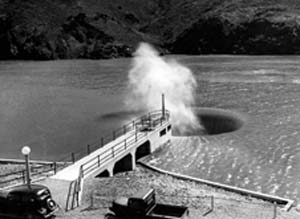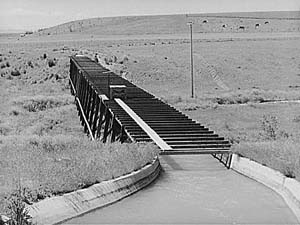
The Owyhee River is far less famous than the Colorado, which carved the Grand Canyon and backs up behind the most famous dam of all--Hoover. But the Owyhee River (pronounced oh-Y-hee) and its Owyhee Dam, 11 miles southwest of Adrian, Oregon, have much in common with Hoover and the Colorado. Owyhee Dam, the tallest in the world when completed in 1932, is significant as a proving ground for engineering techniques used later in construction of Hoover Dam. Not to be outdone, the Owyhee River, as it cuts through the arid uplands of southeastern Oregon, carves “Oregon’s Grand Canyon,” a deep and spectacular gorge where 14 million years of geologic history and numerous archeological and historical sites can be found.
The river’s name, Owyhee, is a local variation of “Hawaii,” commonly used in the 19th century. An 1826 fur trapper account says the river was named for three native Hawaiian fur trappers who were killed by Indians while trapping in the area for the Northwest Company. The Hudson Bay Company also was known to employ Hawaiians, hundreds of whom arrived at Fort Vancouver as indentured servants.
The Owyhee River was an early candidate for damming when the U.S. Reclamation Service (today’s Bureau of Reclamation) was created in 1902 to administer the Reclamation Act, which committed the Federal Government to build permanent irrigation works--dams, reservoirs and canals--to irrigate arid and semiarid lands in the American West. The Reclamation Service surveyed the Owyhee and its neighbor, the Malheur River, in 1903, noting their possibilities for irrigation works. Private irrigation projects, including the Owyhee Ditch, operated in the area as early as 1881, but the Owyhee, like so many Western rivers, was not dependable. Water flowed freely from February to May, but during the summer the Owyhee disappointed.

It wasn’t until 1924 that J. B. Bond, Reclamation’s project manager in nearby Boise, Idaho, recommended that a storage dam be built on the Owyhee at a place called “Hole-in-the-Ground.” The next year, Reclamation outlined an ambitious scheme for the Owyhee Project. At its center was Owyhee Dam, acting as both a storage and diversion dam, augmented by 172 miles of canals, 543 miles of laterals, nine pumping plants, and 227 miles of drains to serve eastern Oregon and southwestern Idaho. All told, the project, which included pumping water from the Snake River, would supply water for 46,000 acres of already irrigated land and 80,000 acres of new lands, with supplemental water for the Owyhee Ditch.
As construction began in 1928, plans were being laid for the much larger Hoover Dam on the Colorado River. Hoover Dam, where construction began in 1931, would tower more than 300 feet above the 417-foot Owyhee and require new construction methods. Engineers needed to know how concrete would act when poured in such massive quantities. What materials were needed? What methods of construction? At Owyhee, many questions were answered; it was Hoover’s testing ground.
The system of cooling coils used later in the construction of Hoover Dam, for instance, first was tested in a 28-foot-square section at Owyhee. Because when hardening, concrete creates great internal heat and expansion, engineers worried that the cooling and contraction would create dangerous cracks in the interior of the dam. To solve the problem, Bureau engineers experimented at Owyhee by funneling artificially cooled water through a network of one-inch coils imbedded in concrete panels. The cooling system subsequently used at Hoover Dam was only slightly altered from that used at Owyhee.
Owyhee claims other engineering advancements. The most visually spectacular feature of the dam is its “morning-glory” spillway, with its ring-gate control mechanism, patented by Bureau of Reclamation engineers John L. Savage and Phillip A. Kinzie. The ring gate enables engineers to control the spillway flow across the entire circumference of the dam’s crest. Morning-glory or glory-hole spillways work like a giant drain, as swirling water drops through a vertical shaft and then discharges downstream through a tunnel. Owyhee’s spillway tunnel, and that at Gibson Dam in Montana, were the first of Reclamation’s dams to use such tunnels. Owyhee’s needle valves, which regulated discharge from the reservoir, also represented an engineering advancement. Owyhee, as well, holds the distinction of being the first dam to have a freight elevator installed, considered a necessity because of its great size--a 417-foot-high, concrete, thick-arch dam.

Before work could begin on Owyhee Dam, a 24-mile railroad to transport rock deposits to the site, as well as other materials, needed to be built. Construction began in January 1928, with laborers paid $4 a day, of which $1.50 was deducted for board and lodging. The first train into the campsite at the dam arrived on October 24, 1929, just five days before the Stock Market crash that heralded the arrival of the Great Depression. Still, work progressed, and at the peak of construction in 1932, the General Contracting Company employed 274 workers. Pouring of mass concrete was completed on May 28, 1932, and that July 17th Owyhee was dedicated. It would not be until 1935, however, that the first irrigation water was delivered.
The Bureau of Reclamation’s Owyhee irrigation project easily is the largest in Oregon, with surrounding farmland used for a combination of livestock grazing and specialty crops such as potatoes, sugar beets, onions, and alfalfa seed. In 1984 a hydroelectric powerhouse was built just downstream from the dam. Today, although still sparsely populated and with limited access, “Oregon’s Grand Canyon” region attracts hunters, fishermen, and river rafters.
Visit the National Park Service Travel Bureau of Reclamation's Historic Water Projects to learn more about dams and powerplants.
Last updated: May 23, 2017
